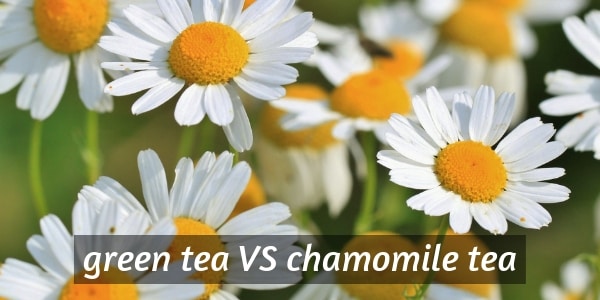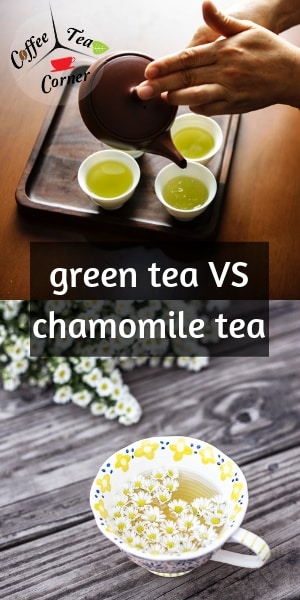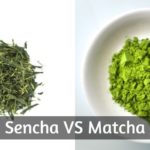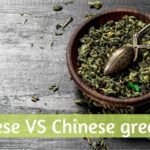When stocking up your tea, which kind of tea to get is always a question. Let's delve into chamomile tea and green tea, since both are widely known and widely used.
What are the differences between chamomile tea and green tea ? We're touching on health and taste as well, and the general benefits of drinking these two teas.
Table of Contents
1. Chamomile tea is a herbal tea (tisane), green tea is a true tea
This is something that many people do not know, unless they are die-hard tea fans. There is a big difference between teas and tisanes, which some tea snobs insist upon too much.
But the difference is necessary to point out since they identify two main types of health benefits and even brewing methods.
So, a chamomile tea is a tisane. This is the name used for all teas that are not made from the Camellia sinensis plant (or even Assamica). All this means is that the tea is not made of tea leaves, but rather a sort of herbal tea.
Chamomile tea is made of the dried flowers of the chamomile, which resembles a daisy very much. It grows both in the wild and in controlled environments, and you can easily make your own if you know where to go on a field trip. More on that later.
Green tea is a true tea, in that is is made from the Camellia sinensis plant. This is the same plant black tea, white tea, oolong, and pu'er tea are made from. Sometimes the Assamica plant is used, though those occasions are fairly rare.
Still, this is the kind of tea that gives caffeine and an entire load of antioxidants to match even berries.
Why does it matter, though ?
For one thins, you know what to expect from your infusion. Tisanes can be infused for longer than teas, and they come in as many flavors and health benefits as there are plants in this world.
And it also means tisanes are caffeine free, since no plant used for such a brew contains caffeine. Unless caffeine has been added afterwards, which should be stated on the tea box.
2. Chamomile tea is wonderful for stress relief and insomnia
Since we've now established the two groups of tea, you'll better understand why chamomile is useful for bedtime.
It's a type of plant that not only contains no caffeine, but actually has a calming, relaxing effect. Much like lavender, linden, or melissa. Not as strong as valerian root tea, but in the same ballpark.
You can use chamomile tea when you've got a small cut on your skin, since it will help clean and heal the wound. Not large wounds, and it definitely needs to be sugar-free when you dab a bit onto the skin.
Chamomile tea has been used for staining linen sometimes, if used in very large concentration. It gives the brew a dark golden, almost amber color. Soaking anything white in it will come out cream-colored.
As for green tea, it's pretty much on the opposite end of the spectrum. Green tea is more for energy, for focus, for getting things done, for staying up and alert.
This is because it contains caffeine, which is always welcome for most people. It doesn't hit you the same way an espresso does, but the caffeine in tea is gentler and more long-lasting.
Green tea is also meant to help with fat-burning and general weight loss, along with a proper diet and exercise plan. It's partly the caffeine and partly the antioxidants in the green tea that make it so potent.
If you're someone who would like to replace their caffeine from coffee with tea caffeine, then you'll want to opt for green tea instead of chamomile
In truth, if you were to compare the two teas, chamomile tea pales in comparison with green tea. Green tea has long been revered as a health drink, and for good reason.
3. Green tea is more of an Eastern drink, chamomile is Western
Now we come to the origin stories of each tea. In short, green tea is possibly more ancient than chamomile tea, and definitely has a richer and more detailed history than chamomile tea.
Green tea started out in China, and the earliest record of any kind of tea was made in China somewhere in the 3rd century AD. It's suspected that tea drinking was a thing even as early as the 16th century BC, since the rule of the Shang Dynasty.
This means that both green and black tea are incredibly old tea types, and they were very treasured drinks.
Mostly green tea was used as a sort of energy drink, brewed and sipped throughout the day. It was also known for its medicinal properties, though that was later documented.
So green tea is pretty ancient. It's been brewed and drunk for centuries, and the method has been perfected. The health benefits have been studied, though there is still more to research.
Even so, the widely popular belief that green tea is a health drink still amplifies its effects, in a way. Believing something is good for you actually makes it work even better, so that is worth mentioning as well.
Chamomile tea on the other hand comes from the West, Europe to be exact. It started out as a medicinal drink used in traditional medicine, along with several other healing plants.
Records of its use aren't very clear, and the flowers used for the brew are widely scattered across Europe. It's also been found in the U.S., since it's a plant that grows very easily, though not everywhere.
What's important though is the fact that chamomile tea sprung up in different parts of Europe, kind of on its own. People started taking notice of its benefits, especially in the Greek and Roman empires.
Chamomile tea is something most grandmas know about, and have probably used, especially in very rural parts of the West. For example my own grandmother grew up in the rural parts of East Europe, and is a firm believer in chamomile tea.
I've had it as well, since it was always part of the stock of tea we had at home. My own mother isn't a fan of tea, but I guess that can skip a generation.
4. Chamomile tastes more pleasant than green tea
In terms of taste, chamomile tea is more pleasant than green tea. Green tea is very bright, green, almost like green grapes.
It's astringent, and can become very bitter if brewed wrong.
Not many people can handle green tea, and it;s often in need of some sugar. Adding milk to it will only ruin the flavor. Milk is not something that goes with green tea, or even Matcha.
So getting used to the taste of green tea can take quite awhile, and even after a couple of weeks of 'training', the taste still might bother you. For one, I know green tea is too harsh for me on its own.
I've had it before, plain and with no sugar, and it was very hard to like. Which is why I always opt for a green tea blended with some fruits or flower petals, to make the taste more palatable.
I think many people can understand me there.
As for chamomile, it too can have a slightly unpleasant taste if you drink too much or too often. Still, it's got more of a flowery note, and none of the astringence of a green tea.
It resembles the taste and smell of pollen, since the whole flower is used for this kind of tea.
If the chamomile tea grown cold, it can become harder to drink, since that flavor profile is not very pleasant when cold. It'll still do its job, but a part of chamomile tea calming you down is the fact that you drink it warm (or hot).
So when you brew yourself a nice cup of chamomile, you don't really need much to make it taste better. A bit of sugar, maybe, but way less than you would add to green tea.
Chamomile goes great with honey or honeycomb, and it creates a very deep flavor. Lemon zest can be a welcome addition as well. Not lemon juice though, since it can overpower the chamomile.
(If you like this article so far, you can pin it to your Pinterest board by clicking the image below. The article continues after the image.)
5. Chamomile is easier to make from scratch than green tea
When looking at the bag of tea you've just purchased, you might wonder how it's made. Well, green tea does require a lot of labor.
There is the tending to the tea plant, then picking the leaves in a certain time of the year, usually Spring.
Unless you live close to the Equator you're going to have a very hard time growing tea, since it requires a specific temperature, humidity level, elevation, and soil.
Then there is the processing of the tea leaves, including withering them, steaming them, pan-searing them, rolling them, and every other step I forgot to mention here.
The amount of work that goes into making your cup of green tea is amazing, and it's honestly very well worth the price green tea comes with.
As for chamomile, it too requires some labor. The upside is that it's easier to produce.
Chamomile grown pretty much everywhere it's not too hot. You'll find it growing in fields, on mountainous regions, on the hillside, and it's easy enough to find.
Or course, if you like in the especially dry and sandy parts of California, you're going to have a tough time finding chamomile. It you were in upstate New York though, you could easily find these flowers.
You can, as long as you know the right plant to pick, make your own chamomile tea. The plants grown on their own, and once you pick them you'll need to dry them out in a single layer over the period of a couple of days.
Your home will smell like chamomile for days, and if you're allergic to pollen then this is a very bad idea to try.
If you're not, then after the flowers have dried (we only need the flower part) and you've made sure they're free of any insects or dirt, you can gather them up into a tea tin and store for up to 6 months.
Herbal teas lose their potency faster, but they're still sensitive to light and air and moisture. So make sure you only make a batch that you can use up in 6 months.
Of course, you can always just plant some chamomile in your backyard and harvest the flowers from there.
6. Green tea is not recommended for babies, chamomile tea is safe
If you've got small children or even a very young baby, then this will be of interest. Both with green tea and with chamomile, the baby needs to be older than 6 months, else you risk upsetting his immune system.
So if your child is 2 years old for example, giving him green tea will not be recommended. This is because green tea can upset the stomach if take on an empty stomach, and toddlers are infamous for not wanting to eat.
Even if he did manage to eat something, it would still be in a small amount and the green tea could still possibly affect him.
Another reason you should think twice about giving green tea to a young child is because of the caffeine content. You're essentially giving him a very diluted energy drink, minus the sugar.
As for chamomile tea, this is something that many people freely give their young children and even small babies. I too had chamomile tea when I had an upset stomach or was very way too restless, even for a baby.
Of course, this tea should be given in a diluted form, and in small to moderate amounts. It's useful when trying to calm a young child to get him to sleep, or in a fit of anxiety.
As for the taste, I think children will welcome chamomile tea better than they would green tea. Especially if you add in a little honey, and a slice or two of strawberries.
The strawberries won't do much in terms of taste, but they will scent the tea and fool the taste buds.
Can you combine green tea with chamomile tea ?
Combining these two teas might sound like a good idea, but it's probably for the best if you keep them separate. As with all things, like attracts like.
Putting a calming and soothing tea in the same cup as an energizing, caffeinated tea will only counteract many of the effects of the chamomile.
The antioxidants of the green tea will still do their job, I see no reason why they shouldn't.
The caffeine will work as well and keep you up, which is going to be odd, given how calming chamomile can be. You'd be in an awake yet dazed state, and that's a bit hard to manage.
Your stomach would probably be fine and not suffer in any way.
Still, it's a very odd combination and not a recommended one. A quick search on the internet will bring you a few results stating that this tea blend (green tea with chamomile) is amazing and you should definitely buy it. I call bull on that.
If you want to blend your green tea, blend it with something relaxing like jasmine that doesn't also put you to sleep.
And if you want to blend your chamomile tea, add something like rooibos for a delicious taste, and possibly some valerian for a good night's sleep. Valerian smells very bad though, so you've been warned.
Final thoughts
Whichever tea you've got, I hope you'll be happy with it. Remember that both green tea and chamomile have their place in the world. They do very different jobs, yes.
But drinking chamomile tea before bed will help ease the mind, and drinking green tea throughout the day will keep you up and running.
I grew up drinking herbal teas, even if my mother wasn't a fan. In high school I started drinking a couple of cups of linden and chamomile teas, every night while reading a book.
I went to sleep very easily and it was my routine for a long time, almost until my senior year.
If you want to know more about coffee or tea, feel free to check the related articles below. Who knows what else you might find ?






